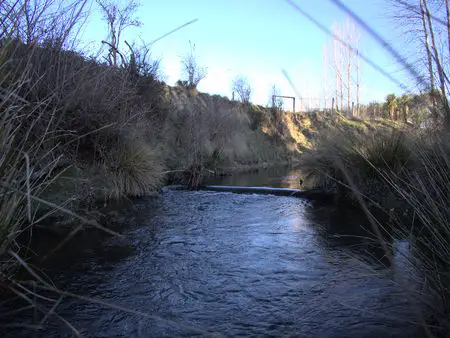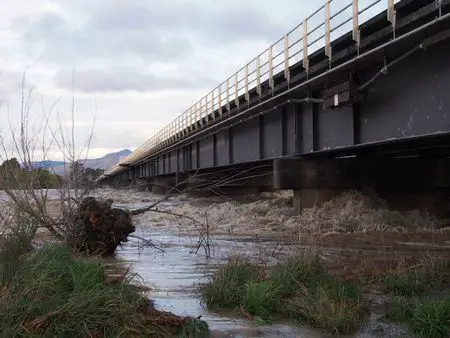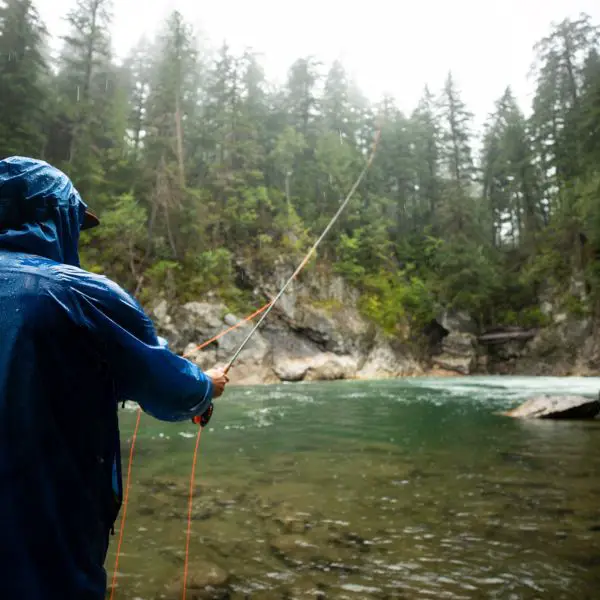Sitting at home with the rain falling brings up the question: is trout fishing in the rain worthwhile?
Rainy weather can be an excellent time to trout fish. Trout are not only more active, but they are also generally in the mood to feed. That is because rain lowers water temperatures, increases oxygenation, and dislodges all sorts of tasty insects.
While the short answer is yes, the long answer is more complicated. Read on to learn more about trout fishing in rainy weather.
Why is trout fishing better in the rain?
- Trout are photophobic, they prefer to stay out of the light. Rainy days and cloudy and overcast.
- Rain droplets themselves can immediately make the water less clear. This in turn makes the trout feel more confident.
- Rain increases oxygen levels. The physical splash of raindrops mixes atmospheric oxygen into the surface water increasing total oxygen levels.
- Rain can lower water temperatures. In the summer, when flows and low and warm. A cold rain can bring some welcome relief to the trout. Rain can easily drop the water temperature by several degrees.
- More food. Rain washes all sorts of terrestrial insects into rivers and streams. As water levels start to rise, even more insects get washed into the river. During the rain, there is simply more food available to the trout.
- Small baitfish become more active due to the abundance of insects washed into the river. That in turn catches the attention of larger predatory trout.
- Fewer Anglers. Many fishermen are fine weather anglers only. They want to be comfortable, so they stay home on rainy days. This means less competition on the water.
Personal Anecdote – Trout feeding frenzy after rain
One memory from my childhood really made an impact on just how good fishing can be in the rain. It had been a long hot and dry summer, but the fine spell was ended by several days of heavy rainfall.
On the second day of the rainstorm, my father drove me to see a natural phenomenon. We walked down to the local spring stream and the longest pool was swarming with fish life. It was like a moving bowl of spaghetti, with eels and numerous fish breaking the surface.
While the eels were porpoising around the surface, In amongst them trout were busy feeding. This feeding frenzy lasted for two days. I have never seen a feeding anything quite like it again, but it was proof enough to convince me that the rain can trigger trout and other fish to feed.
Do Mayflies Hatch In the Rain?
Most large mayfly hatches are triggered by a rise in temperature. Rain typically lowers temperatures.
But dizzily weather does not spell disaster for a hatch. If the temperature is still warm, the mayflies will still try to hatch. The moist conditions mean it takes longer for the Duns (adult stage) to dry their wings and take flight.
This delay in flight leaves them vulnerable to rising trout, and the trout know it. So some of the best dry fly fishing can be had on a hatch during light drizzle.
A downpour of heavy rain does not necessarily stop a hatch from occurring, but it certainly spells disaster for any Dun trying to take flight (Still good fishing). If the rain continues too long, the drop in water temperature can prevent a hatch from the beginning.
Most insects are less active during the rain
Most insects are less active during the rain. On overcast rainy days damselflies, cicadas, crickets, grasshoppers, and houseflies are all less active. In fact, most flying insects want to keep dry.
On the positive, the blood-sucking midges and mosquitoes also go into hiding.
While in Scotland, I found fishing during the rain was the most relaxing time to fish the local lochs because the swarms of relentless midges were in hiding.
The same holds true for New Zealand sandflies and most species of mosquitoes. Still best to be prepared, they return in force the moment the weather clears.
Worms often come to the surface during the rain
Worms are one notable exception.
During the rain, they get flooded out of their barrows. So are often found wiggling across the ground.
Many of which end up in the river to be eaten by a hungry trout.
Fishing after a major rain event can be very productive.
Fishing after rain, when the rivers are dropping, can be among the most productive times. The reason why is simple, the increased current dislodges and washes an abundance of insect life downstream. The trout are ready and taking full advantage of it.
There is also plenty of drowned terrestrial insects, which were washed from their riverside homes. These insects often drift deeper in the water column, so the traditional terrestrial drys might not work.
Personal Anecdote – Fishing after heavy rains
Opening weekend, in my hometown, means rain. If it was not raining on opening day, it would have rained the day before.
I am not one to skip an opening day. So rain, shine, wind, hail I will head out for a fish. Sometimes the major rivers will be roaring in flood, but there is always somewhere to fish.
For me this is normally in headwater tributaries. They raise quickly, but they also drop quickly. Meaning they become low enough to fish while the big rivers are still roaring.
In such small streams, I have had some of the best brown trout fishing of my life. Best of all, almost no one fishes them.
One spring morning, the stream had a good size fresh in it. The water was full of leaves, trigs, and dislodged insects. As I waded upstream, it soon become apparent the trout were taking full advantage of the abundance of food. The usually wary trout were almost hypnotized by the constant flow of food. It was a very productive day.

Another year, the opening day coincided with a full-force storm. The amount of fishable water was very low. I spent the morning on a small spring creek but the conditions were too miserable.
So later that day, I decided to check out a local reservoir. Over the years, this reservoir slowly filled in with silt and weeds. Destroying what was once a fairly productive trout fishery.
Then someone introduced pest fish, which were later destroyed by the environmental agency. In early fall, the local fish and game stocked it with a few surplus brown and rainbow trout. Most of the ones which survived the pot hunters swam over the dam with the first fall rain.
Anyway, jumping back to the new season. With storm clouds still brewing. I fished the outlet channel first because it is the only place not smothered with weeds. What greeted me was a dozen trout feeding just in front of the overflow culvert.
I was able to line up the largest rainbow who readily took my nymph. On release, I noticed a fresh puncture wound in its jaw. I text a local trout addict who I knew was planning to check out the reservoir on opening day, and my suspicion was true. He landed it a few hours prior to my arrival. That rainbow had such a strong urge to feed that even getting caught did not put it down.
Can trout be caught in flooded rivers?

Sometimes it rains so much, that our nice little trout streams can turn into raging brown torrents.
As a general rule, if the river is brown, angry, and raging do not fish it. Trout in such wild conditions struggle to stay alive.
Many get crushed by rolling boulders, others are displaced and get carried miles downstream. In one of my local rivers, rainbow trout get washed several miles out to sea after large floods. These are not steelheads, just displaced river fish.
An easy way to tell if a flooded river is clear enough to fish is to wade out to knee depth. If you can see your boots, then it is usually clear enough for the trout to see your lure or fly.
If you do want to fish a flood, it is best to avoid the main current. The force of the water is too powerful for the trout to hold there. They seek out eddies, backwaters, and areas of low flow
. On more than one occasion I have spooked trout from the extreme shallows. Maybe they were foraging for worms in the submerged grass.
I have not seen it myself, but a farmer once told me that he has seen trout gathering in spring eruption zones during floods. He could see the brown trout resting in the pocket of spring water surrounded by liquid mud.
Such areas will also be worth a look.
Fly fishing during the rain?
What nymphs to use when fishing in the rain?
In most cases, I will suggest fishing the traditional patterns. The ones which are proven to work in your local water. The aquatic life is not going to change much simply because there is more flow. If the water is slightly cloudy, consider using a size larger to improve visibility, maybe even go as far as using a bright bead.
The faster flow might necessitate the use of heavier weighted nymphs so they sink fast enough to reach the strike zone. Sight fishing is going to be difficult, so I highly recommend the use of an indicator.
Now, if the rain starts to get heavy, then a lot of terrestrial insects are probably getting washed downstream. In such a situation, I like to fish large ‘generic-looking nymphs to try and imitate a drowned terrestrial.
Best Dry Flies when fishing in wet weather?
Some anglers might even ask, Do mayflies even hatch in the rain? Is it even worth fishing a dry fly? Well, yes they do.
Some of the best dry fly fishing occurs during overcast showery conditions. They emerge in great numbers but get stuck on the surface because their wings take longer to dry making them easy pickings for any feeding trout
So, if you suspect a hatch is occurring dry fly fishing can be very productive. Here is some advice.
Rain decreases visibility on the water surface, so I suggest using a slightly larger than normal dry fly to improve visibility.
Sometimes, all the splashes can get the trout extra excited, in such situations casting a large terrestrial or even a popper fly can be very rewarding.
How to Select the Best Streamers for rainy weather?
Streamers and tiny wet flies are an excellent option for cloudy water. I will pick larger bolder patterns,s in dark colors. A black wooly bugger or rabbit fly will be my pick. But olive or dark brown likely also work.
As conditions get even murkier, that is the time to break out the crazy bright colors. Do not be afraid to fish a bright orange or yellow fly. Anything to stand out against the dirt.
Spin fishing in the rain?
If you are fishing on the rainy day itself, I have seen trout aggressively feed towards the surface. So a surface lure or popper can be very effective. Remember to retrieve it extra slowly to give the trout plenty of time to strike.
After the river has risen a bit, and the water becomes cloudy. It is a great time to dust off the spinning gear. Spinners and other metal lures have several advantages over flies in dirty water.
First, inline spinners give off a lot of vibration. Such a loud lure is simply easier for the trout to sense against the roar of the river. Many jerkbaits and hard body minnows contain internal rattles, this also helps grab the trout’s attention.
Spinners, typically are larger than streamers. Which again assists visibility. When fishing dirty water, I go straight for a YoZuri Pin Minnow in the brightest, most obnoxious color in my box. I have lost count of how many brown trouts I caught on this lure in cloudy water.
Finally, there are more scented options available. The most common are the scented soft plastic lures.
Make sure to check your hooks every few casts, nothing dulls the action of a spinning lure like a tail of slime.
Bait fishing for trout in the rain.
This might just be the best time to bait fish for trout. During the rain, a lot of worms leave their barrows and travel overland. Many end up getting washed away. Trout and other fish are unlikely to turn down such an easy meal.
Floating a worm across a pool is an excellent rainy day option. If fishing a lake, target stream mouths. Simply allow the current to carry the bobber and worm into the lake. A lot of worms and bugs get washed into the lake and that is where the trout gather to intercept them.
If you want to read more about using worms for bait, I have written an article here.
Safety when trout fishing in the rain
We must take care when fishing rivers in the rain. While it might only be light showers where you are. Torrential downpours could be hammering the mountainous headwaters further upstream. A wall of water could be raging downstream to meet you.
Always, have an escape plan in mind. Know how you are going to get out of the river and back to the car quickly If the river starts to rise. Avoid fishing canyons and other steeply walled sections of rivers. In such places, water levels rise rapidly and it is possible to get trapped.
Lastly, if there is lighting, think twice before waving that 9ft fly rod around out in the open. Graphite conducts electricity, and your rod might just be at the highest point. When I hear thunder approaching, I head back to the car.
What to wear when fishing in the rain?
I recommend wearing full waders and a wading jacket. This full outfit helps keep you dry and more importantly warm. On a warm summer’s day, it might be tempting to leave the waterproof gear at home. I personally get cold after standing in the rain for several hours.
In the Fall, Freshes caused by heavy rain can trigger spawning runs
After a long hot summer, and dry fall. The first serious rains can drop the river’s temperature and trigger in brown trout the urge to spawn. Large numbers of pre-spawned trout can start pushing upstream. While on average brown trout only move a few hundred yards per day, some have been known to migrate several miles.
In coastal regions, the increased freshwater concentration flowing out to sea also heralds the return of many sea-run trout.
The days following a fall fresh can see some seriously productive fishing. On the other hand, some areas might see a reduction in the number of trout.
Summary – trout fishing in the rain
I hope you have found this helpful, if you need any questions or additional advice to offer then feel free to comment below. Otherwise, I hope you can get out, get wet, and catch some trout in the rain.

